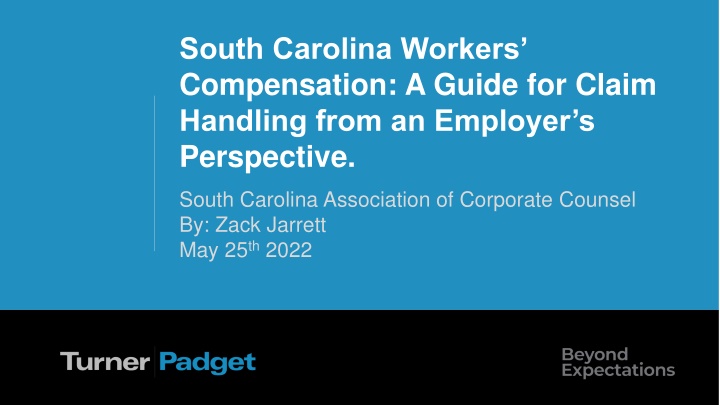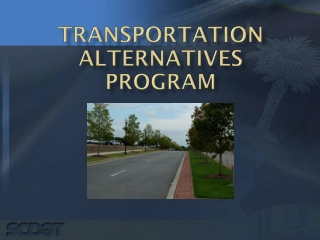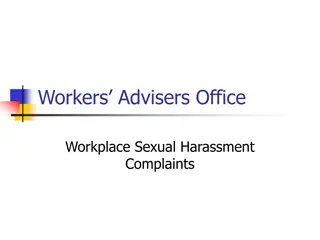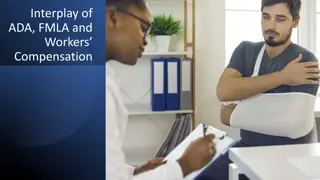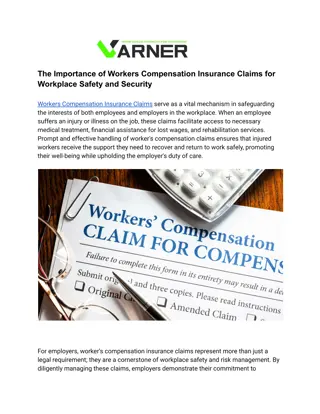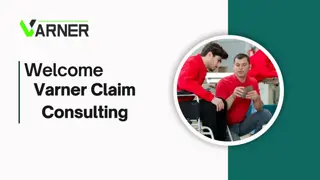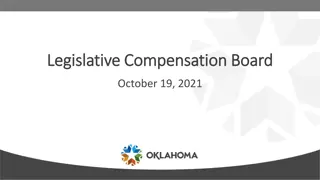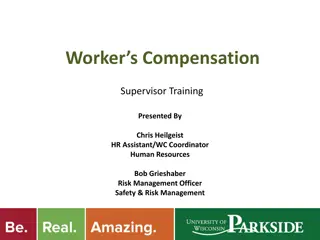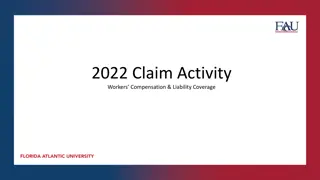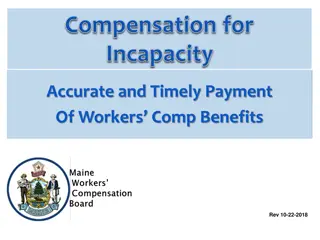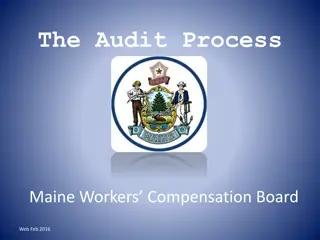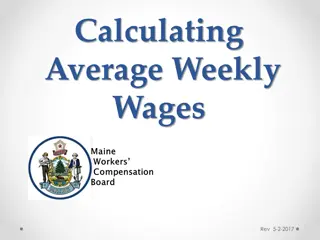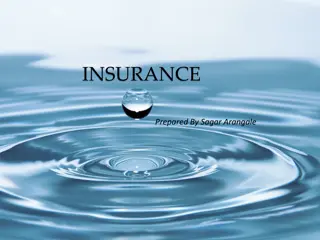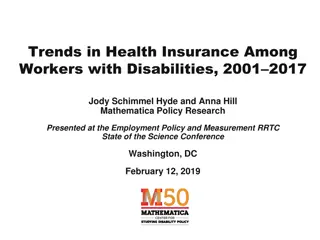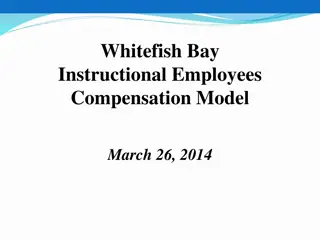Guide to South Carolina Workers' Compensation Insurance
This guide provides valuable insights from an employer's perspective on handling workers' compensation claims in South Carolina. It covers the role of the Workers' Compensation Commission, eligibility criteria for insurance, who can file a claim, and the elements of a compensable claim. The information is sourced from the South Carolina Association of Corporate Counsel and offers a comprehensive overview for employers navigating workers' compensation matters in the state.
Download Presentation

Please find below an Image/Link to download the presentation.
The content on the website is provided AS IS for your information and personal use only. It may not be sold, licensed, or shared on other websites without obtaining consent from the author.If you encounter any issues during the download, it is possible that the publisher has removed the file from their server.
You are allowed to download the files provided on this website for personal or commercial use, subject to the condition that they are used lawfully. All files are the property of their respective owners.
The content on the website is provided AS IS for your information and personal use only. It may not be sold, licensed, or shared on other websites without obtaining consent from the author.
E N D
Presentation Transcript
South Carolina Workers Compensation: A Guide for Claim Handling from an Employer s Perspective. South Carolina Association of Corporate Counsel By: Zack Jarrett May 25th 2022
South Carolina Workers Compensation Commission The Commission is a creature of statute, which the General Assembly established for the purpose of administering and adjudicating all claims arising under the South Carolina Workers' Compensation Act. S.C. Code Ann. 42-3-10 (2015). Mission statement: To provide an equitable and timely system of benefits to injured workers and employers in the most responsive, accurate, and reliable manner possible.
South Carolina Workers Compensation Commission 7 Commissioners appointed by the Governor with the advice and consent of the Senate for terms of six years and until their successors are appointed and qualify. S.C. Code Ann. 42-3-210(A) (2015). Claims are heard before a Single Commissioner. Can be appealed to the Full Commission, then Court of Appeals, then Supreme Court of South Carolina.
Current Commissioners T. Scott Beck, Chairman. Avery B. Wilkerson, Jr. Aisha Taylor Susan S. Barden Melody L. James Gene McCaskill Michael R. Campbell II Each Commissioner serves a 6 year term and can be re-appointed. Interesting fact: A Commissioner does not have to be a lawyer in South Carolina.
Who Needs Workers Compensation Insurance? Employers conducting business in South Carolina with 4 or more regular employees. Includes full-time and part-time family members. Includes family members of the business owner. Regular Employees Not seasonal worker Not volunteer Not Independent Contractor Employee is defined in S.C. Code Ann. Section 42-1-130.
Who Can Bring a Claim in South Carolina? Injured workers hired in South Carolina Via telephone, email etc. Does not have to be in-person. Business physically located in South Carolina Accident occurred in South Carolina Usually not an issue, but can be when Claimant s cross the border often as a part of business. Truck drivers, construction workers, etc. Claimant lives in a different state.
Elements of a Compensable Claim Accidental injury unexpected event or result. Normal job duties resulting in an injury can be compensable. Cannot be intentional No fault system pretty easy burden to meet Employment relationship No independent contractors or volunteers Arising out of Employment Accident is connected to a work activity In the course of Employment Accident occurred in place related to work
Time Requirement for Reporting a Claim Claim must be reported to an Employer representative within 90-days of the accident. This is a Supervisor, HR, or safety person etc. Not a casual co-worker. 90 days is a long time. Typically the longer the gap in reporting time, the more questionable the claim. From an Employer standpoint it is important to have a thorough reporting system in place. Make sure that employees know who they are to report claims to and the procedure for reporting the accident. This is an affirmative defense. Must be plead on a timely filed Form 51.
Statute of Limitations Claimant has two years from the date of accident to file a claim. This requirement gets blurred with repetitive trauma claims. Runs from when the Claimant knew or should have known that the work activities were causing the symptoms. Usually documented by medical evidence or when a doctor tells the Claimant that work is causing the symptoms.
Types of Injuries Injury by Accident S.C. 42-1-160 Repetitive Trauma S.C. 42-1-172 Occupational Disease S.C. 42-11-10 Special Injuries S.C. 42-1-160
Injury by Accident (42-1-160) Most common type of claim. Standard injury to a specific body part. Must be accidental in nature. Must occur in the course and scope of employment. Medically complex claims require a physician statement causally relating the injury to the accident. Must be stated to a reasonable degree of medical certainty.
Repetitive Trauma (42-1-172) An injury that is gradual in onset and caused by the cumulative effects of repetitive traumatic events. Heightened burden on Claimant. Commissioner must make a finding that medical evidence supports that the job activities were repetitive and resulted in the condition. Expert medical evidence expert opinion or testimony stated to a reasonable degree of medical certainty by a licensed and qualified medical physician. Typically see this as carpal tunnel, or assembly line injuries.
Occupational Disease (42-11-20) Exposure claims. Typically things like mold exposure, fumes, or illnesses. This is where Covid claims would be. The standard is that the Claimant must prove that the work place contributed to the condition and that they were more susceptible to the condition at work than in the general public. Hazard must be peculiar to the employment. Claimant must prove: 1 Exposure occurred at work 2 Does not result from climatic exposure outside of work. 3 - condition is not a contagious disease equally exposed to outside of work. Or an ordinary disease of life. 4 Condition is not a chronic disease of the skeletal joints.
Special Injuries Stress Mental-mental claims Heart attacks Strokes, Embolisms Aneurysms. These claims are typically not compensable unless there is expert medical evidence to indicate that the conditions at work were extraordinary and unusual resulting in the condition.
Steps for the Employer Before an Accident Post-hire medical questionnaire. Thorough job description and have the Claimant sign. Safety training. Consider ergonomic expert if job may be repetitive. Include workers compensation training in new hire paperwork or orientation. Make sure that the Claimant knows the chain of command for reporting a claim.
Steps for the Employer after and Accident Complete an accident report as soon as possible. Have the Claimant review and sign the accident report. If possible, have the Claimant write out what happened in their own handwriting. Interview Witnesses Have them complete written witness statements. Memory is the freshest May no longer employed when the claim is litigated. Offer the Claimant Medical Treatment Send the Claimant to approved occupational doctor. Not an acceptance of claim. If Claimant refuses, have them sign something saying that they were offered care and refused.
Steps for the Employer After an Accident File a Form 12A once the claim has been reported. Be sure to turn the Claim in to the insurance carrier. Follow up with the Claimant regarding their medical status. Have the Claimant sign paperwork if they meet with the Employer or refuse medical treatment. Document the file with the mindset that the claim may be litigated in the future. Offer light duty work if it can be accommodated, and if the Claimant has restrictions.
Discovery More for the adjuster, but get a recorded statement. Medical Canvas. On the front-end, obtain a detailed personnel file and application. If the Claimant is terminated, be sure that the reason for the termination is clearly documented with supporting evidence. Document all write-ups and infractions. Treat the Claimant like you would any other employee.
Initial Medical Care Employer should have a designated occupational doctor where they refer an injured worker. Regardless of questions on the validity of the claim, go ahead and send the Claimant to the occupational doctor. The provision of initial medical treatment is not acceptance of the claim. The information that the Claimant gives at that appointment is usually helpful in fraudulent claims because they have not yet consulted a lawyer. Defendants can deny a claim at any point.
Benefits Two types of benefits under the Workers Compensation Act: Medical Benefits (42-15-60) Exactly what it sounds like. Medical treatment directed by the carrier. Compensation Benefits TTD temporary total disability benefits. (42-9-10) Completely out of work due to injury. TPD temporary partial disability benefits. (42-9-20) Reduced ability to work. Pay the Difference on a Form 15s. PPD partial permanent disability. (42-9-30) Final rating. What defendants pay out in settlement or Order of the Commission. P&T - Permanent and total disability. (42-9-10) Claimant cannot return to the workforce. 500 week limit Wage Loss (42-9-20) Not P&T but more than general disability. Based on 340 weeks. Lifetime Benefits (42-9-10) Quadriplegia, paraplegia, permanent and severe brain injury.
Average Weekly Wage/Compensation Rate Average weekly wage total of Claimant s earnings for 52 weeks before the accident divided by 52. (S.C. Code Ann. Section 42-1-40) Compensation rate 2/3 (.6667) of the average weekly wage. Statute allows for alternative methods for calculating the aww/cr when the standard method does not result in a fair and just result. Like Employee, industry standard, contract of hire, etc. This information is to be reflected on a Form 20 completed by the Employer. 2022 maximum compensation rate - $963.37
Communications with Physicians Governed by Regulation 67-1308. Need to be careful because all communications are discoverable. Claimant or their counsel must be included on correspondences and given 10 days notice of the correspondence before sent to the physician. Employer or carrier cannot contact or communicate with physician directly, but the Claimant s counsel can. Exception is a brand new provider, or IME doctor.
Claim Resolution Proceed to a hearing and receive an Order from the Commission. Mediation Mandatory in disputed death cases, lifetime benefit claims, or permanent and total disability allegations. Settlement Form 16A Clincher Settlement
Settlement If Claimant is represented then approval of settlement is not required by a Commissioner If unrepresented, Commissioner must hear terms of settlement and agree. Typically need MMI and a Form 14B. Informal Conference Form 16A Resolves indemnity only. Medical portion of claim stays open. 1 year change of condition Usually the Claimant remains employed. Clincher Settlement Full and final resolution of claim. Closes out medical and indemnity. Some Employer s request a resignation and release.
Resignation and Release With Settlement Not a part of the Workers Compensation claim. Must be handled a separate agreement. Employer can request that the settlement be conditioned on the Claimant agreeing to a resignation and release. We cannot force a Claimant to agree to the resignation and release. Claimant can opt to proceed to a hearing and let the Commission issue an aware rather than agreeing to the resignation and release. The workers compensation team are not employment lawyers. However, we have an employment team at Turner Padget to assist with the Resignation and Release issue.
Lemon v. Mt. Pleasant Waterworks Lemon v. Mt. Pleasant Waterworks, 429 S.C. 59, 837 S.E.2d 738 (Ct. App. 2019) , 429 S.C. 59, 837 S.E.2d 738 (Ct. App. 2019) FACTS The claimant was involved in an admitted work accident where he sustained an injury to his back. Prior to the admitted accident, the claimant suffered four separate workplace injuries resulting in workers' compensation claims against Mount Pleasant Waterworks and its carrier (collectively, Respondents ). The Claimant injured his back as a result of two of those four accidents. From the four prior workers compensation claims, the claimant received an aggregate amount of 199 weeks of compensation benefits. Those benefits included temporary benefits and permanent disability benefits. ARGUMENTS BEFORE THE SCWCC Claimant alleged injuries to his back and legs and sought permanent and total disability benefits Respondents argued that, in the event the claimant is awarded permanent and total disability, they were entitled to a credit for the 199 weeks of compensation benefits the claimant received for his four prior claims against Mount Pleasant Waterworks. PROCEUDRAL POSTURE The Appellate Panel held that Claimant was permanently and totally disabled under subsection 42-9-10(A). The Appellate Panel further found Respondents were entitled to 321 weeks of credit against a maximum 500-week award of permanent and total disability benefits. To reach that amount, the Appellant Panel held that Respondents were entitled to an offset of 122 weeks of temporary disability benefits received on the current claim and, relying on subsection 42-9-170(B), were also entitled to a credit of 199 weeks of benefits from the claimant's prior unrelated workers' compensation claims.
Lemon v. Mt. Pleasant Waterworks Lemon v. Mt. Pleasant Waterworks, 429 S.C. 59, 837 S.E.2d 738 (Ct. App. 2019) , 429 S.C. 59, 837 S.E.2d 738 (Ct. App. 2019) ARGUMENT ON APPEAL The claimant argued the Appellate Panel erred in offsetting his award of permanent and total disability benefits against prior benefits---199 weeks---received for his previous four claims. HELD In reversing, in part, the court held that the Appellate Panel erroneously relied on section 42-9-170 to award 199 weeks of credit since that section is inapplicable to an award under subsection 42-9-10(A). The court held that the plain and unambiguous language of section 42-9-170 limits its application to subsection 42-9-10(B) awards. Thus, the Appellate Panel erred in applying section 42-9-170 to credit Respondents with 199 weeks of compensation paid for the claimant's prior benefits. TAKEAWAY For a permanent and total disability award made under subsection 42-9-10(A), no offset occurs under section 42-9-170. Rather, offsets are limited to permanent injury as specified in Section 42-9-30 or Section 42-9-10(B).
Lemon v. Mt. Pleasant Waterworks, No. 28027 (May 12, 2021) PER CURIAM: We issued a writ of certiorari to review the court of appeals' decision in Lemon v. Mt. Pleasant Waterworks, 429 S.C. 59, 837 S.E.2d 738 (Ct. 17 App. 2019). We now dismiss the writ as improvidently granted.1 DISMISSED AS IMPROVIDENTLY GRANTED. Footnote 1: Petitioners moved to supplement the record two days prior to oral argument. With Respondent's consent, the motion to supplement the record is granted. However, these additional materials do not affect the disposition of this appeal. End of case notes.
York v. Longlands Plantation York v. Longlands Plantation, 429 S.C. 570, 840 S.E.2d 544 (2020) , 429 S.C. 570, 840 S.E.2d 544 (2020) FACTS The decedent died in a work-related incident In a contest for death benefits under the Workers Compensation Act, only the decedent s mother and his girlfriend claimed death benefits. ARGUMENTS BEFORE THE SCWCC In seeking benefits, the girlfriend claimed she was the decedent s common-law wife under section 42-9-110 or, alternatively, that she was a dependent under sections 42-9-120, --130. PROCEDURAL POSTURE The commission found that because the girlfriend was engaged in an illicit relationship in violation of South Carolina s fornication statute, section 16-15-60, she could not recover the death benefits as a matter of public policy. ISSUE Whether a decedent s girlfriend could qualify as a dependent under section 42-9-120? The girlfriend abandoned her argument that she was common-law married to the decedent under section 42-9-110.
York v. Longlands Plantation York v. Longlands Plantation, 429 S.C. 570, 840 S.E.2d 544 (2020) , 429 S.C. 570, 840 S.E.2d 544 (2020) HELD [I]n order to qualify as a dependent under [section 42-9-120,] the claimant must show a legal relationship or alternatively, an affirmative undertaking with the decedent. Additionally, to fall within the ambit of section 42-9-120, there must be something more than intermittent financial assistance; instead, the claimant must rely on the decedent for the reasonable necessities of life. The court did not address legal dependency since the SCWCC did not analyze whether the decedent owed a legal or some other obligation to the girlfriend. Notwithstanding, the Court held that the girlfriend failed as a matter of law to prove factual dependency. To prove factual dependency, the court, relying on prior precedent, reiterated certain factors to consider: medical insurance coverage, braces, household utilities, groceries, car expenses, clothing, summer camp, and made payments on the indebtedness on the family home. Another factor, though not dispositive, is the status listed on a tax return (e.g. whether decedent filed joint taxes with the claimant or whether the decedent listed the claimant as a dependent). In finding that the girlfriend could not prove factual dependency or that she relied on the decedent for the reasonable necessities of life, the Court noted that: (1) the girlfriend and the and the decedent filed taxes separately; (2) the girlfriend and decedent did not claim any dependents on their taxes; (3) the girlfriend and the decedent had an on-again off-again relationship; and (4) during their relationship, the girlfriend owned her own home and filed as head of household.
Frampton v. S.C. Dep't of Nat. Res Frampton v. S.C. Dep't of Nat. Res., No. 5726, 2020 (Ct. App. Nov. 18, 2020) ., No. 5726, 2020 (Ct. App. Nov. 18, 2020) FACTS Prior to September 4, 2010, the claimant had a preexisting neck condition (cervical radiculopathy). On September 4, 2010, the claimant experienced neck pain and stiffness following a site inspecting in which he riding in an automobile across a bumpy dove field. Subsequently, his treating physician diagnosed him with having cervical and trapezius strains. DNR paid for this visit. The Claimant reached MMI on September 20, 2013 ARGUMENTS BEFORE THE COMMISSION The claimant sought an award of permanent and total disability for a neck and right arm injury he contended that he sustained because of the dove field incident. The claimant denied any preexisting condition to his neck. In its answer to the claimant s hearing request, DNR admitted the claimant sustained an injury on the date of the dove field incident. Yet, DNR, in both its answer and prehearing brief, contended that the claimant was not entitled to benefits. At the hearing, DNR, for the first time, maintained that the claimant could not meet his burden to prove that he sustained an aggravation injury to his neck pursuant to section 42-9-35. PROCEDURAL POSTURE The Appellate Panel found that claimant failed to meet his burden of proving a compensable aggravation injury to his preexisting neck condition under subsection 42-9-35(A)(1) as a result of the dove-field incident. ARGUMENTS BEFORE THE COURT OF APPEALS The claimant contended that Appellate Panel erroneously required him to prove a compensable injury to his spine after DNR admitted liability. Claimant posited that because DNR admitted the injury and paid for some of his medical treatment, the parties believed the only disputed issue at the hearing before the single commissioner would be the extent of his spinal injury and whether his arms were injured. The Claimant also contended that DNR did not properly present section 42-9-35 as a defense because it failed to specify the statute as a defense on its Form 51 or in its prehearing brief. He further contended that because DNR admitted the injury, he was not on notice he would be required to prove liability. According to DNR, its admission that the claimant sustained an injury did not absolve him of his burden of proving entitlement to benefits, including his burden under section 42-9-35. To that end, DNR maintained that section 42-9-35 is a statutory prerequisite to compensation benefits when there is a preexisting condition, rather than an affirmative defense.
Frampton v. S.C. Dep't of Nat. Res Frampton v. S.C. Dep't of Nat. Res., No. 5726, 2020 (Ct. App. Nov. 18, 2020) ., No. 5726, 2020 (Ct. App. Nov. 18, 2020) Holding: As a threshold matter, the court found that DNR was not foreclosed from relying on section 42-9-35 as a defense despite not asserting it prior to the initial hearing. The Court reasoned that DNR did not have notice of the claimant s preexisting neck injury until shortly before the initial hearing when it received certain medical records. In addition, when DNR raised section 42-9-35 as a defense at the initial hearing, the claimant failed to offer an objection. The court also recognized that this was not an affirmativedefense that must be raised in a Form 51. Next, even though DNR paid for the claimant s medical treatment following the dove field incident and admitted an injury within its answer to the claimant s hearing request, the court found that DNR was not estopped from contesting liability. The court noted that DNR had consistently denied the claimant was entitled to benefits and, relying on prior precedent, found no waiver merely because the employer paid for the claimant s initial treatment. Having determined that section 42-9-35 was applicable as a defense, the court then held that substantial evidence supported the Appellate Panel s conclusion that the claimant failed to prove under that statute that the dove field incident aggravated his preexisting neck condition. The court noted that the claimant only referenced the existence of the preexisting condition when DNR presented him with his neurosurgeon's medical records at the initial hearing. Even assuming, arguendo, that the claimant had met his burden under section 42-9-35, the court still found his claim non-compensable on the grounds that he failed to establish that his neck injury arose out of his employment with DNR. Precisely, the court observed that the claimant s medical records were devoid of any mention of the dove field incident and that he had already seen a neurosurgeon at least six months before the incident for the same injury.
Patel v. BVM Motel, LLC., Patel v. BVM Motel, LLC., No. 5813 (Ct. App. March 31, 2021) No. 5813 (Ct. App. March 31, 2021) Issue Whether a claimant s death was compensable under the bunkhouse rule? Facts Decedent was employed as a housekeeper at the Best Western Point South in Yemassee. As a condition of her employment, Decedent was required to live at the motel and be on call when on the premises she did not clock in or out. At approximately 8:01 a.m. on August 16, 2015, an intruder, who was neither an employee nor a registered motel guest, fatally shot Decedent Decedent was dressed for work wearing a company uniform when her body was found at the motel Arguments Employer argued that Decedent's death did not arise from her employment, asserting there was no link between Decedent's employment and her assault during the armed robbery. Claimant responded that consistent with the "bunkhouse rule," Decedent's death arose out of and in the course and scope of her employment because Decedent was required to be on the motel premises at all times and was essentially on duty day and night.
Patel v. BVM Motel, LLC., Patel v. BVM Motel, LLC., No. 5813 (Ct. App. March 31, 2021) No. 5813 (Ct. App. March 31, 2021) Bunkhouse Rule In South Carolina's leading case on the bunkhouse rule, Pierre v. Seaside Farms, Inc., 386 S.C. 534, 549, 689 S.E.2d 615, 623 (2010), our supreme court held: "[a]lthough merely being on an employer's premises, without more, does not automatically confer compensability for an injury, we believe the circumstances of Pierre's accident including the facts that he was required by the nature of his work to live on the employer's premises and such residence furthered the interests of the employer, the injury arose from a hazard existing on the employer's premises, and he was making reasonable use of the premises establish the requisite work connection and compel a finding that Pierre's injury arose out of and in the course of his employment at Seaside Farms." Holding: In finding that Decedent s death was compensable, our Court of Appeals focused on the following: Substantial evidence in the record established that Decedent was on the work premises where she was required to live and be on call and was dressed in her uniform at the beginning of the workday when the armed robbery occurred. No evidence existed that the assault was personally motivated, and there is no evidence it was caused by any condition peculiar to her Although our supreme court "has never stated an injury must stem from a particular hazard or risk of the employment," see Nicholson, 411 S.C. at 388 89, 769 S.E.2d at 5, we cannot ignore that the requirement that Decedent live at the interstate-adjacent motel brought about her exposure to the armed robbery that led to her death.
Keene v. CNA Holdings, L.L.C. Keene v. CNA Holdings, L.L.C., No. 28052 (August 11, 2021) , No. 28052 (August 11, 2021) Facts CNA corporate predecessor Hoechst hired Daniel Construction Company (Daniel) to build a polyester plant, then retained them to provide all maintenance and repair workers at the plant. Hoechst provided in its contract with Daniel that the workers must be insured and Hoechst would pay for it. Seay was employed by Daniel in a maintenance role at the plant. His work exposed him to asbestos and he was later diagnosed with mesothelioma. Seay and his wife sued CNA claiming Hoechst acted negligently in using asbestos and in failing to warn of its dangers. Seay s daughter Angie Keene took over the lawsuit after Seay died from mesothelioma, adding survival and wrongful death causes of action. CNA argued Seay was a statutory employee and Workers Compensation Law provided the exclusive remedy for his claims. The circuit court disagreed and denied CNA Holdings' motion for summary judgment. A Spartanburg County jury awarded Seay's estate $14 million in actual damages and $2 million in punitive damages. The trial court denied CNA Holdings' motion for judgment notwithstanding the verdict, again finding Seay was not a statutory employee. The court of appeals affirmed. This appeal followed. Issues/Holdings Exclusive remedy? Whether Seay was a statutory employee under S.C. Code 42-1-400 and -410? The court refocused on the key question posed by the statute: whether the work contracted out is part of the owner s trade, business or occupation. While the three tests arising from Bridges, Boseman, and Marchbanks remain valid considerations, courts should now focus initially on what the owner decided is part of its business. Because Hoechst made a legitimate business decision to outsource maintenance and repair work and ensured the workers were insured, Seay is not a statutory employee and CNA is not immune from his family s claims. The original purpose of the statutory employee doctrine was to prevent business managers from outsourcing work for the purpose of avoiding workers compensation costs. The original purposes of the statutory employee doctrine are not served by making CNA immune from its wrongful conduct.
Keene v. CNA Holdings, L.L.C. Keene v. CNA Holdings, L.L.C., No. 28052 (August 11, 2021) , No. 28052 (August 11, 2021) Dissent Under the three tests for determining whether a worker is a statutory employee, Seay was Hoechst s statutory employee. The court must consider whether the worker's activities : (1) are an important part of the trade or business of the employer; (2) are a necessary, essential, and integral part of the business of the employer; (3) have been previously performed by employees of the employer. Seay s activities met the first two tests, and there is no reason to alter the case-by- case analysis provided by these tests. S.C. Supreme Court issued an unpublished opinion on April 5, 2022 and rehearing was denied.
